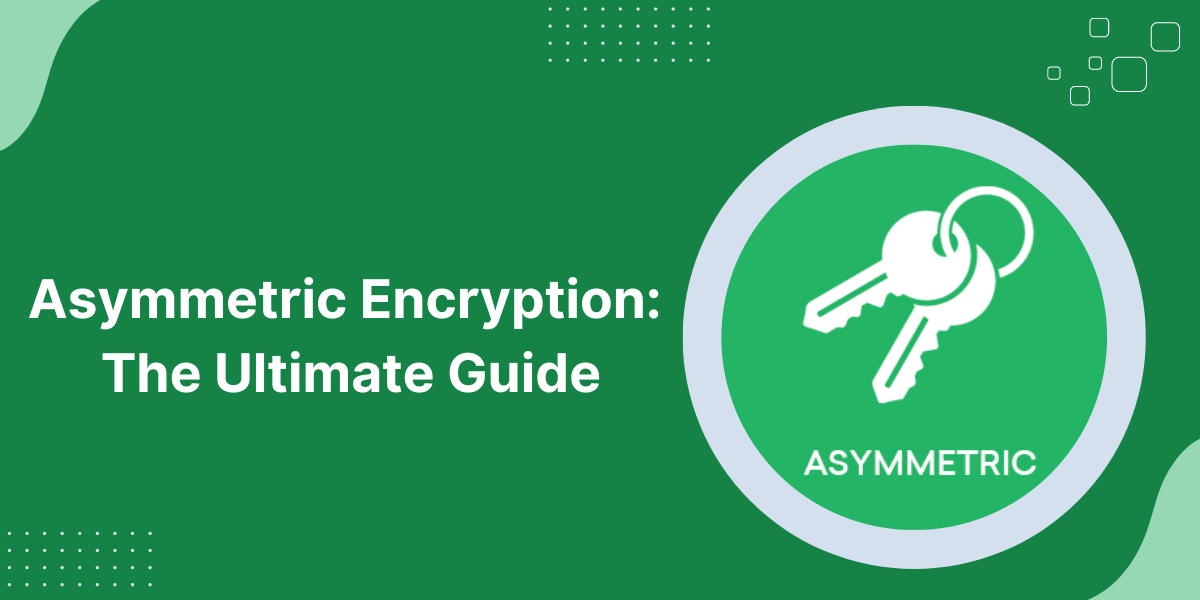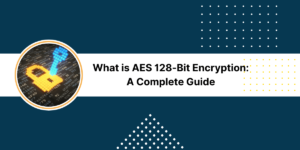Asymmetric encryption, also known as public-key cryptography, is an essential concept in modern information security. This beginner’s guide will introduce asymmetric encryption and how it works.
What is Asymmetric Encryption?
Asymmetric encryption uses two different keys, a public key, and a private key, to encrypt and decrypt information. The public key can be widely distributed, while the private key must be kept secret. Here are the basics:
- The public key is used to encrypt information. Anyone can use the public key to encrypt a message, but only the holder of the private key can decrypt it.
- The private key is used to decrypt information. It must be kept private and secure by its owner. The private key is needed to decrypt any information encrypted with the corresponding public key.
- The two keys are mathematically linked together through cryptography. However, it is computationally infeasible to derive the private key from the public key. This is what makes asymmetric encryption secure.
This differs from symmetric encryption, where the same key is used to encrypt and decrypt information. Asymmetric encryption allows information to be securely communicated to an individual over an insecure channel like the internet.
Why Use Asymmetric Encryption?
Asymmetric encryption provides important advantages that make it widely used in modern computing and information security:
- Secure Key Distribution – There is no need to securely distribute private keys, as only the public key needs to be distributed. This enables secure encrypted communication between parties who have never directly exchanged keys.
- Digital Signatures – The private key can digitally sign information, proving the authenticity and integrity of data. The signature can be verified with the public key but not forged without the private key.
- Enhanced Security – Even if the private key is somehow compromised, it does not reveal the historical encrypted data as a symmetric key would. New public/private keypairs can easily be generated and re-distributed.
Common applications that use asymmetric encryption include HTTPS websites, VPNs, email encryption, cryptocurrency wallets, and digital certificates.
How Does Asymmetric Encryption Work?
Asymmetric encryption uses mathematical functions to generate the public and private keys and encrypt and decrypt data. Here is a simplified overview of how it works:
- Key Generation: The public and private keys are generated using an algorithm that produces a mathematical relationship between them. Popular algorithms include RSA and ECC (elliptic curve cryptography).
- Data Encryption: Data is encrypted by the sender using the public key. The encrypted information can only be decrypted by applying the matching private key.
- Data Decryption: The encrypted data is decrypted by the recipient using their private key. Only the private key can decrypt data that was encrypted with the corresponding public key.
- Digital Signature: The private key can also be used to digitally sign information to prove authenticity. This signature can be verified using the public key.
The algorithms use complex mathematical functions involving very large prime numbers to secure the keys and encryption. The details behind these algorithms are beyond the scope of this introductory guide.
Asymmetric Encryption Algorithms
There are various cryptographic algorithms that are used to implement asymmetric encryption and key generation. Here are some of the most common ones:
RSA
- RSA stands for Rivest, Shamir, Adleman who first publicly described it in 1977.
- It is widely used for secure data transmission and digital signatures.
- RSA relies on the difficulty of factoring very large prime numbers to generate keys.
- Key sizes are typically 1024 to 4096 bits. The larger the key size, the more secure but slower.
ECC (Elliptic Curve Cryptography)
- ECC uses properties of elliptic curves over finite fields to create keys.
- It provides similar cryptographic strength to RSA but with much shorter key sizes.
- A 256-bit ECC key offers equivalent security to a 3072-bit RSA key.
- ECC is efficient and provides performance benefits, especially for mobile devices.
Diffie-Hellman
- Diffie-Hellman enables two parties to jointly establish a shared secret key over an insecure channel.
- This key can then be used for subsequent symmetric encryption of messages.
- It is used in protocols like SSL/TLS and IPsec to establish secure VPN tunnels.
There are various other algorithms like DSA (Digital Signature Algorithm) and ElGamal that have specific applications in asymmetric cryptography.
How is Asymmetric Encryption Used?
Here are some common ways that asymmetric encryption is used in information security:
Secure Web Browsing
- HTTPS websites use SSL/TLS to provide encrypted web browsing.
- The website has a digital certificate with its public key to encrypt data to the server.
- Session keys are exchanged using asymmetric encryption to enable symmetric encryption of the browsing session.
Email Encryption
- OpenPGP and S/MIME protocols allow email to be encrypted using asymmetric cryptography.
- The recipient’s public key is used to encrypt the message which can only be decrypted with their private key.
- Digital signatures on emails also use private/public keypairs for authentication.
User Authentication
- Public and private keys can be used for user authentication instead of passwords.
- The private key acts as the user’s identity for authentication and digital signatures.
- The public key verifies those signatures without compromising the private key.
Blockchain Technology
- Public and private keypairs enable users to securely interact with blockchain networks like Bitcoin and Ethereum in a pseudonymous manner.
- The public key acts as the public address for receiving transactions. The private key authorizes the transfer of funds.
- Digital signatures provide transaction integrity and authentication.
Secure Shell (SSH)
- SSH allows secure remote login access between devices.
- Asymmetric encryption is used initially to exchange a symmetric session key between the client and server.
- The symmetric key encrypts the remainder of the interactive session.
Common Misconceptions
There are some common misconceptions about asymmetric encryption:
- It does not provide perfect secrecy like a one-time pad cipher. The algorithms have potential vulnerabilities that may be exposed in the future with advances in quantum computing and mathematical analysis. Additional symmetric encryption is often layered for improved security.
- The private key must be securely stored and protected. If compromised, the key could be used to impersonate the owner or decrypt their historical data exchanges. Proper key management hygiene is essential.
- Encryption alone does not guarantee message integrity or authenticity of the sender. Digital signatures and message authentication codes (MACs) should be used to provide additional assurances.
- Key generation requires high entropy random numbers. Using predictable or weak keys severely compromises the strength of the encryption.
- End-to-end encryption with user-managed keys provides the highest security. Relying solely on a public key built into a service or application introduces potential vulnerabilities.
Best Practices for Implementation
Here are some best practices to follow when implementing asymmetric encryption:
- Use well-known and tested algorithms like RSA or ECC rather than trying to invent proprietary cryptography.
- Choose sufficiently large key sizes, such as at least 2048 bits for RSA and 256 bits for ECC.
- Generate keys from high-quality random numbers from cryptographically secure pseudorandom number generators.
- Properly manage keys, keeping private keys highly secured and distributing public keys through trusted channels. Use key rotation periodically.
- For digital signatures, use secure hashing algorithms like SHA-256 to hash the data before signing it with the private key.
- Combine asymmetric encryption with symmetric encryption, message authentication codes, and secure protocols for robust security.
- Use encryption libraries and tools that have been vetted by security experts whenever possible. Avoid trying to implement cryptographic primitives directly unless absolutely necessary.
- Keep up to date on cryptographic advancements and phase out older algorithms and key sizes as they become insecure.
Conclusion
Asymmetric or public-key cryptography enables secure and private communication over insecure networks like the internet. It provides unique capabilities like digital signatures that are important to modern information security systems. While the mathematics behind the scenes are complex, the basic principles of public and private keypairs and their ability to encrypt and authenticate data are essential for anyone to understand today.
Proper implementation requires care and expertise to ensure keys are robustly generated and managed. Asymmetric encryption forms a critical component of the overall security toolbox alongside other mechanisms like symmetric encryption and secure hashing.
Frequently Asked Questions
What are the differences between asymmetric and symmetric encryption?
Symmetric encryption uses the same secret key to encrypt and decrypt data while asymmetric encryption uses a public key to encrypt and a private key to decrypt. Asymmetric encryption allows secure communication without prior key exchange.
Is asymmetric encryption slower than symmetric encryption?
Yes, asymmetric encryption and key generation requires complex mathematical operations and is much slower than symmetric encryption. Hybrid systems are often designed to use slower asymmetric encryption to establish a symmetric session key for efficiency.
What key sizes should be used today for RSA and ECC?
For RSA, a minimum of 2048-bit keys are recommended but 4096-bit provides future-proofing. For ECC, 256-bit keys are recommended for general use. Keys larger than this provide diminishing returns on additional security.
How can users without technical expertise use asymmetric encryption securely?
User-friendly software and services are available that enable average computer users to benefit from asymmetric encryption. For example, installing an email client with built-in support for OpenPGP encryption or using a VPN service that handles the underlying public key infrastructure for you. However, it is still important to choose trusted providers.
Is asymmetric encryption susceptible to quantum computing attacks in the future?
Some asymmetric algorithms like RSA could potentially be broken by quantum computing attacks when large quantum computers are built. However, methods like post-quantum cryptography and switching to quantum-resistant algorithms aim to maintain security in the future.
Do both parties need keypairs in asymmetric encryption?
Typically yes, both the sender and receiver generate their own public/private keypairs. However, in some cases like public websites, only the server has a certified keypair and the user only needs the server’s public key to encrypt information.
Can asymmetric keys be used more than once?
Yes, the public and private keys can be reused many times to encrypt/decrypt data with the same keypairs. However, for better security, key rotation is recommended periodically to limit the amount of data secured by a single keypair.



